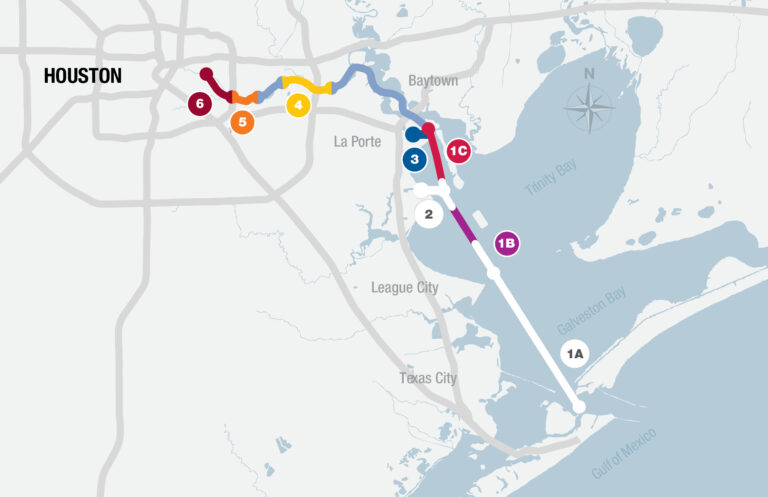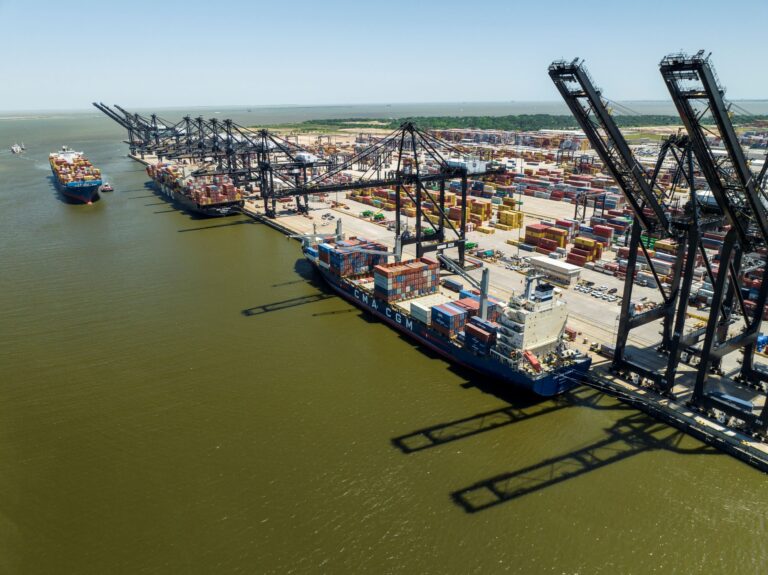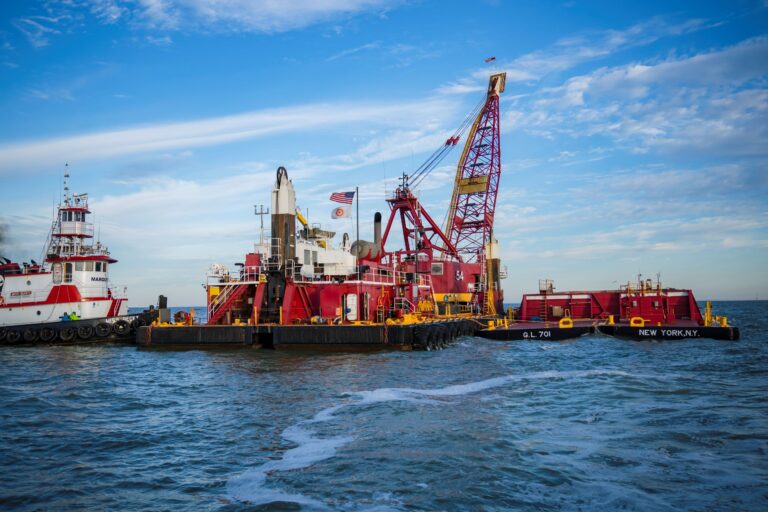Yesterday
The Houston Ship Channel is a national asset, thanks to a century of collaboration and continued investment in critical improvements to the waterway. The capacity of the ship channel to safely and efficiently handle commerce has driven the tremendous growth of the Port of Houston and its contributions to the region, state, and national economies.
Today
The Houston Ship Channel is home to the number one U.S. port for waterborne tonnage. The 200-plus private and public facilities alongside the Houston Ship Channel, collectively known as the Port of Houston, provide significant benefits to the U.S.
Tomorrow
More demand means more cargo and bigger ships. This means improvements to the Houston Ship Channel must continue to safely maintain and grow the nation’s economy.
A wider and safer channel that maintains two-way traffic is the backbone of the diverse commerce plying the waterway as well as the rail, road and other critical infrastructure at the Port of Houston, facilitating the growth of vessel size, exports and domestic manufacturing.
Much is at stake – it is critical that the necessary infrastructure be in place to accommodate future economic opportunities. It is estimated that more than $50 billion has been invested by the employers and manufacturers at the Port of Houston to handle increasing exports and imports. These opportunities can be hindered without the capability of efficiently exporting these products to the world marketplace, thereby jeopardizing the associated economic benefits of jobs, national energy security and export growth.
Houston Ship Channel Expansion (Project 11) Environmental Initiatives
The Houston Ship Channel and the commerce that moves along it provides significant benefits for the national and regional economies and job markets. Delivering these benefits can have a cost in terms of the environment, wildlife or the air around us. Port Houston is committed to offsetting those impacts and implementing positive solutions. Building on our tradition of environmental stewardship and the successful program of using dredged material for beneficial uses, Port Houston is working with its partners to help ensure that this project once again provides significant environmental benefits – to wildlife, water quality and regional air quality.
Bird Islands

All useful materials, such as clay or sand, produced from the channel improvements in Galveston Bay will be utilized for environmental benefits. Some of this material will be used to construct four bird islands in Galveston Bay creating up to a total of 20 acres of new foraging and nesting habitat for skimmer and ground-nesting birds.
Experience shows that birds thrive within these man-made islands. Twenty years ago, Evia Island was built by a partnership among Port Houston, U.S. Army Corps of Engineers, the Beneficial Users Group (BUG)1 and Houston Audubon, using dredged material from an earlier channel project. Today, this 7-acre island is home to nearly 10,000 nests, ten bird species — including Great Blue Herons, Great Egrets, Snowy Egrets, Tricolored Herons and Brown Pelicans — and the largest gathering of nesting bird pairs in the entire Galveston Bay system.
Oyster Reefs

Existing oyster reef along the sides and bottom of the ship channel will be removed during the dredging process. While the oyster reefs will naturally repopulate these areas over time after the channel project is completed, as they did after the last deepening and widening project, these impacts must be mitigated. Therefore, to replace oysters affected by the dredging process, a portion of the clay, sand and shell produced from the project’s Galveston Bay components will be used to build approximately 324 acres of replacement oyster reef pads to provide growth-enabling habitat for these water-dwelling invertebrates.
Oysters provide numerous environmental benefits. As filter feeders, they draw in approximately 20 to 50 gallons of water each day, to feed on the nutrients from the bay and then release filtered water. Oyster reefs also help prevent erosion, resisting tidal flows and acting as barriers during storms, and helping to protect the productive Galveston Bay estuary system, one of the largest in the United States.
But still storms can be difficult on them: Hurricane Ike devastated 60 percent of the oyster reefs in Galveston Bay. However, reef pads built as part of Project 11 will be made using resilient materials in locations identified by experts as those most likely for the oysters to thrive in.
As oysters settle to the bottom of the Bay, they will naturally continue building reef structures. It is anticipated that some of these new reefs will be in areas where they can be harvested, helping to support the Galveston Bay’s oyster fishery industry, which contributes about $9 million annually to the Texas economy and supports 175 jobs.
Marsh
Portions of the useful materials coming from the channel dredging in Galveston Bay will be utilized to build three new marshes, up to 800 acres in total size. Two will be built adjacent to existing man-made marshes located south of Atkinson Island. Plans also include a triangular-shaped marsh located within Galveston Bay, with a bird island at each of its three corners. Through a combination of planted grasses, and natural recruitment and spreading of seeds, these marshes are expected to provide both wetlands and shallow open-water habitat.
Marsh creation using dredged material has already proven to be successful in Galveston Bay. Previous Houston Ship Channel projects are still supporting the building of approximately 3,300 acres of intertidal salt marsh in the bay, creating one of the largest wetland restoration efforts of its kind in the nation.
Marshes are an essential part of our coastal ecosystem. They provide food and protection for wildlife, improve water quality and help mitigate flooding.
Air Quality
Project 11 is expected to improve regional air quality by increasing the efficiency of vessel movements and reducing potential congestion within the Port of Houston. At the project’s completion, these efficiencies are expected to result in an initial 3 percent reduction of nitrogen oxides (NOx) from vessel emissions. These reductions are also expected to continue incrementally over the next eleven years, to reach 7 percent annually. This is important because NOx are detrimental to public health and cause ozone.
Specifically, these reductions are achieved through the various channel improvements. Deepening the channel allows more fully-loaded and larger ships, resulting in fewer transits and reduced emissions for the same amount of cargo. Channel widening reduces emissions by facilitating continued safe two-way traffic, so vessels will not have to wait as long for clearance to depart from the docks or move inbound from the Gulf of Mexico. Finally, Project 11 also includes improvements to turning basins, so the larger vessels expected in the future can travel shorter distances to turn around within them.
1 The Beneficial Users Group, or BUG, consists of Port Houston, the U.S. Army Corps of Engineers, the Environmental Protection Agency, National Marine Fisheries Service, National Resource Conservation Service, Texas Parks and Wildlife Department, the Texas General Land Office and the U.S. Fish and Wildlife Service.
Houston Ship Channel Expansion (Project 11) and Other Bay Users
The Houston Ship Channel, the nation’s busiest waterway, travels through Galveston Bay, which is a major destination for recreational and commercial activities, such as boating, ecotourism, fishing and bird watching. While the goal of Project 11 specifically is to expand the channel, we must all continue to work together, as we have in the past, on initiatives that can enhance the benefits to all users of the bay while maintaining the economic and safety priorities of the channel.






